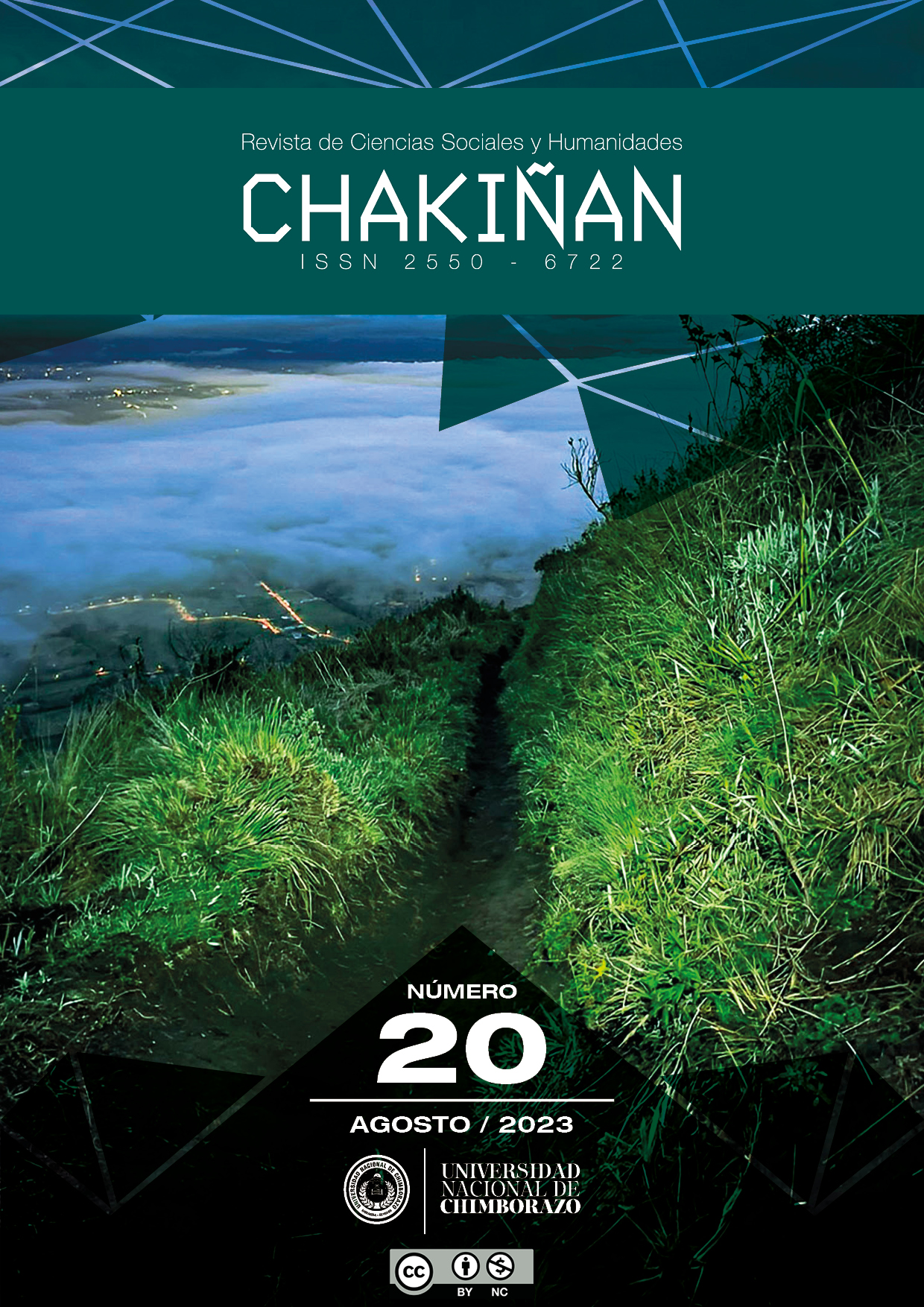EL APRENDIZAJE INTEGRADO DE CONTENIDOS Y LENGUAS EXTRANJERAS (AICLE) PARA DESARROLLAR HABILIDADES DE REDACCIÓN EN INGLÉS
Main Article Content
Abstract
En un mundo en permanente cambio, los métodos tradicionales de enseñanza de idiomas no resuelven las necesidades comunicativas en lenguas extranjeras que favorecen el conocimiento y la adaptación a contextos educativos cambiantes. El método AICLE es ampliamente utilizado para desarrollar habilidades tanto en el aprendizaje de la lengua como en otras áreas del conocimiento, permite fortalecer las capacidades docentes para asumir la enseñanza de los contenidos de las diferentes materias en una lengua extranjera. El objetivo de esta revisión bibliográfica es recopilar información significativa y existente sobre el método CLIL y su contribución en el campo educativo. Se utiliza el enfoque descriptivo documental de investigaciones recientes relacionadas con el tema de estudio, basado en los fundamentos teóricos de la educación bilingüe. La revisión bibliográfica muestra que al enseñar la lengua extranjera como vehículo para instruir contenidos de otras materias, los estudiantes comprenden la necesidad de aprender la lengua para apropiarse de los conocimientos de la materia y permite a los docentes explorar su propio contexto de enseñanza, reflexionar e identificar factores que pueden mejorar su práctica docente, especialmente en la inclusión de actividades de escritura en inglés.
Downloads
Article Details
Conference Proceedings Volume
Section

This work is licensed under a Creative Commons Attribution-NonCommercial 4.0 International License.
Responsibility of the authors:
The authors are responsible for the ideas and data collected in the manuscripts. They are additionally accountable for the fidelity of the information, the correction of the citations, the right to publish any material included in the text, and the presentation of the manuscript in the format required by the Journal (WORD template). A manuscript forwarded to CHAKIÑAN must not have been published before, nor must it have been submitted to another means of publication.
Copyright:
Published articles do not necessarily compromise the viewpoint of the CHAKIÑAN JOURNAL. The Journal is aligned to the policy of the licence de Creative Commons Reconocimiento-No comercial 4.0 Internacional (CC BY-NC 4.0). Each author retains the right to the paper published in the Chakiñan journal.
Privacy statement
The personal data and email addresses entered in this magazine will be used exclusively for the purposes stated by the publication and will not be available for any other purpose or person.
How to Cite
Share
References
Alegre, L. (2021). Aprendizaje integrado de contenido y lengua extranjera para la enseñanza comunicativa de inglés académico. Revista Arbitrada Interdisciplinaria Koinonía, 6(4), 125-143. https://doi.org/10.35381/r.k.v6i4.1440
Argudo, J., Abad, M., Fajardo, T., & Cabrera, P. (2018). Analyzing a Pre-Service EFL Program through the Lenses of the CLIL Approach at the University of Cuenca-Ecuador. Latin American Journal of Content & Language Integrated Learning, 11(1), 65-86. https://dspace.ucuenca.edu.ec/bitstream/123456789/35843/1/documento.pdf
Barre, P., & Villafuerte, J. (2021). English as a Foreign Language Instruction in Ecuador: Implementation of the Content and Language Integrated-Learning during 2019-2021. English Language Teaching Educational Journal, 4(2), 99-112. https://eric.ed.gov/?id=EJ1311546
Campillo, M. (2017). CLIL methodology in Physical Education classes for bilingual teaching. Lecturas de Educación Física y Deportes, 22(235), 47-51. https://efdeportes.com/efdeportes/index.php/EFDeportes/article/view/54
Cancelas, L. P., & Cancelas, M. Á. (2009). AICLE: estableciendo las bases para trabajar la música en L2. Tavira. Revista Electrónica de Formación de Profesorado en Comunicación Lingüística y Literaria, 1(25), 137-159. https://rodin.uca.es/handle/10498/10704
Cendoya, A., Di Bin, V., & Peluffo, M. (2008). CLIL Content and Language Integrated Learning. Puertas Abiertas, 4(4), 65-68. https://www.memoria.fahce.unlp.edu.ar/art_revistas/pr.4558/pr.4558.pdf
Dávila, M., & Ramos, P. (2013). Design of a model workshop for the subject of social sciences in French of third grade of the integrated educational institution La Candelaria. Pontificia Universidad Javeriana.
Díaz, N. (2021). The CLIL experience of students belonging to the First Year of Secondary Education from a transitional perspective. RIDE. Revista Iberoamericana para la Investigación y el Desarrollo Educativo, 11(22), 1-19. https://doi.org/10.23913/ride.v11i22.864
Fajardo, T. M. F., Argudo, J., & Abad, M. (2020). Language and Teaching Methodology Features of CLIL in University Classrooms: A Research Synthesis. Colombian Applied Linguistics Journal, 22(1), 40-54. https://doi.org/10.14483/22487085.13878
Fernández, A. (2001). A bibliographical selection on the CLIL method (Integrated Learning of Curricular Knowledge and Foreign Language). Contextos Educativos. Revista de Educación 1(4), 217-239. https://doi.org/10.18172/con.494
Griva, E., & Kaskivis, K. (2014). CLIL in primary education: posibilities and challenges for developing L2/FL skills, history understanding and cultural awareness. In N. Bakić-Mirić & D. Erkinovich, Current trends and issues in education: an international dialogue. Cambridge Scholars Publishing.
Lasagabaster, D. (2011). English achievement and student motivation in CLIL and EFL settings. Innovation in Language Learning and Teaching, 5(1), 3-18. https://doi.org/10.1080/17501229.2010.519030
Machado, J. (11 Dec 2019). Ecuador tiene el peor nivel de inglés de América Latina. Primicias. https://www.primicias.ec/noticias/sociedad/idioma-ingles-estudiantes-convenio-educacion-profesores/#:~:text=El%20resultado%20de%202019%20ubic%C3%B3,promedio%20es%20de%2023%20a%C3%B1os
Manzano, B. (2015). CLIL in three spanish monolingual communities: the examples of Extremadura, Madrid and La Rioja. ELIA, 1(15), 135-158. https://doi.org/10.12795/elia.2015.i15.07
Mariño, C. (2014). Towards implementing CLIL (content and language integrated learning) at CBS (Tunja, Colombia). Colombian Applied Linguistics Journal, 16(2), 151-160. https://doi.org/10.14483/udistrital.jour.calj.2014.2.a02
Marsh, D., Maljers, A., & Hartiala, A. (2001). Profiling european CLIL classrooms. Languages Open Doors. University of Jyväskylä.
Palma, S. (2020). Content and language integrated learning in ecuadorian public schools: an analysis of the teachers’ reality. Revista Cognosis, 5(2), 83-102. https://doi.org/10.33936/cognosis.v5i2.2017
Piacentini, V. (2021). CLIL and Science education. A review for a Language focus in Science teaching. Ricerche di Pedagogia e Didattica. Journal of Theories and Research in Education, 16(3), 113-131. https://rpd.unibo.it/article/view/12646
Rueda, M., & Wilburn, M. (2014). Theoretical approaches for the acquisition of a second language from the horizon of educational practice. Perfiles Educativos, 36(143), 21-28. http://www.scielo.org.mx/pdf/peredu/v36n143/v36n143a18.pdf
Salvador, C., Chiva, O., & Colomer, C. (2020). The effect of bilingual Physical Education on students’ Physical Activity. Things are not always as they seem. Cultura, Ciencia y Deporte, 15(43), 53-61. https://dialnet.unirioja.es/servlet/articulo?codigo=7282462
Villamarín-Guevara, J. E., & Fajardo-Dack, T. (2022). CLIL in use: perceptions and experiences of English teachers in public schools. CIENCIAMATRIA, 8(1), 513-541. https://doi.org/10.35381/cm.v8i1.688






